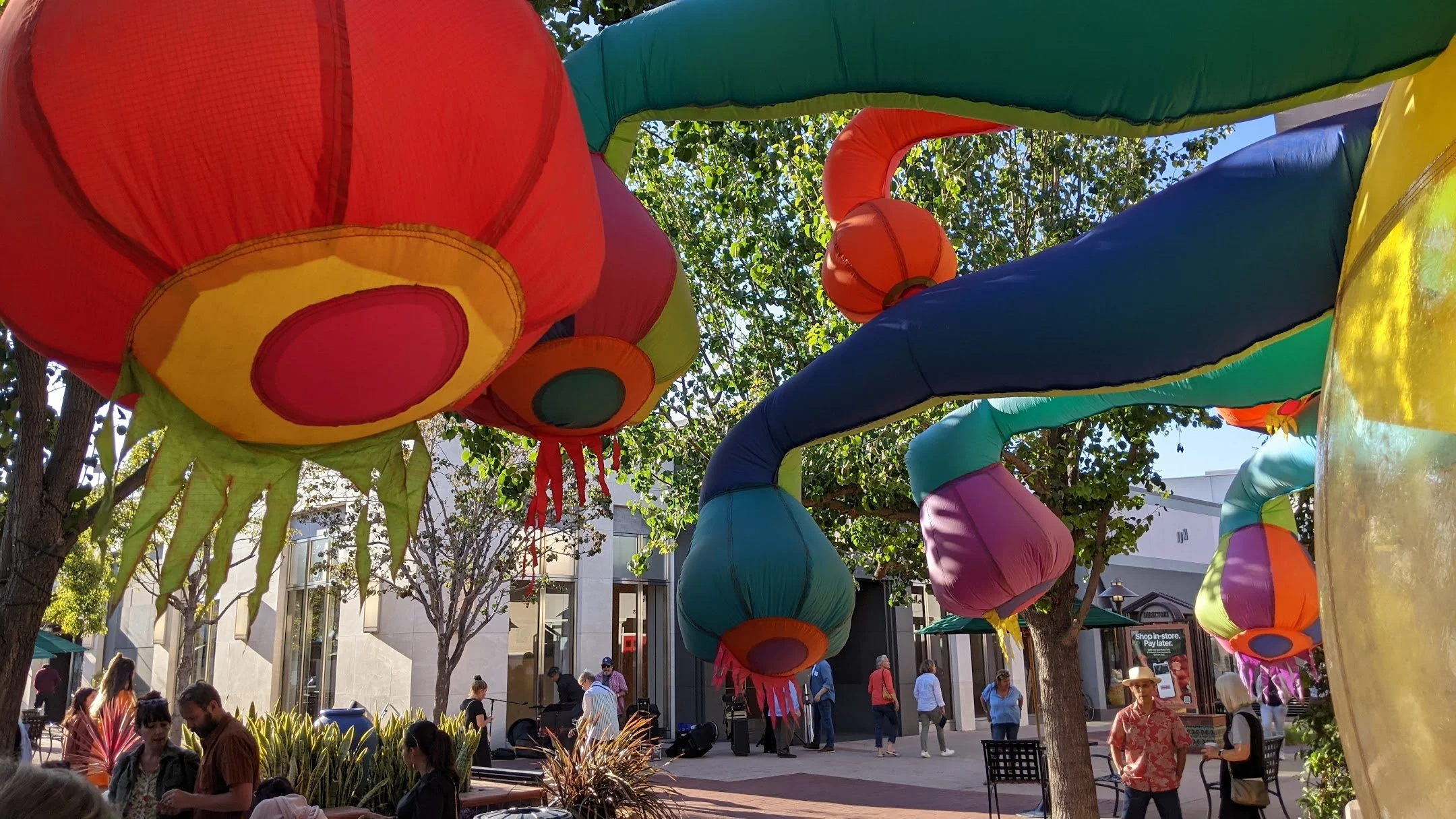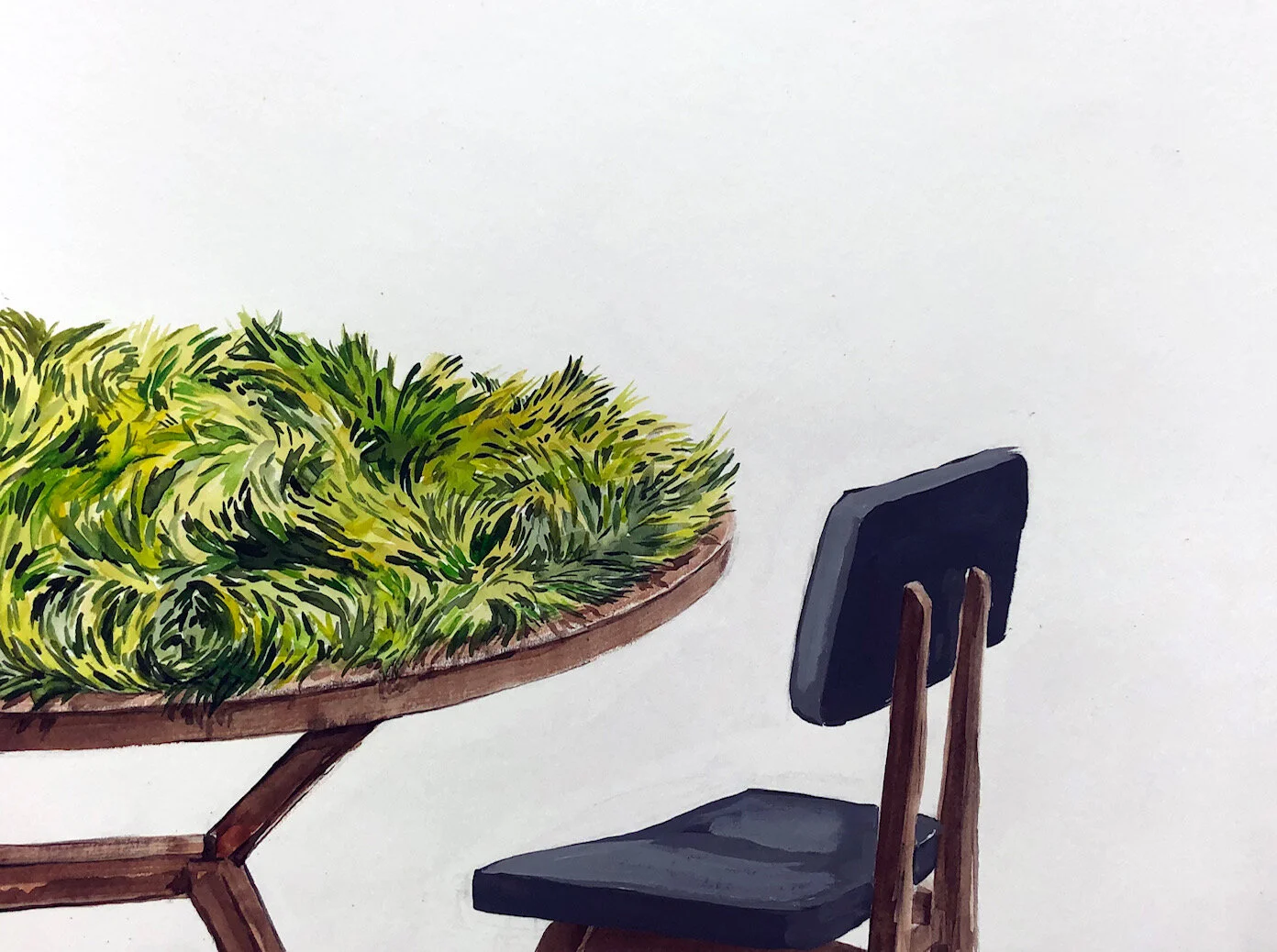A Conversation with Pecos Pryor
By Bay Hallowell
Pecos Pryor: Attention to Loss on view at the Architectural Foundation of Santa Barbara in January and February 2022 was Pryor’s debut, solo exhibition in Santa Barbara. A full-throated response to multiple personal losses, the exhibition featured drawings, prints, and sculptures in various styles. Pryor’s former partner asked, “What do we do with our hands in grief?” in a poem read at her brother’s memorial service. This question became a catalyst for Pryor’s explorations of sorrow and anger. By delving directly into the dark emptiness and shadows of grief, he discovered new life and possibilities, even humor.
Pryor is a graduate of Westmont College and earned an MFA in printmaking at the University of Nebraska-Lincoln. He currently resides in Carpinteria and teaches sculpture at Westmont College, printmaking at Santa Barbara City College School of Extended Learning, and installs exhibitions for SBMA and MCASB.
Pecos Pryor, Attention to Loss (detail)
Bay Hallowell: Mysterious traffic cones greeted visitors outside the entrance to the exhibition—some standing, some oddly toppled over, heavy and made of concrete, blending into the sidewalk. Inside the gallery, visitors encountered a large work table covered with a spectacular array of cones in a dizzying array of sizes and shapes and made of everything imaginable – plaster, stone, tinfoil, paper, clay, eucalyptus wood! On the patio behind the gallery, there were more cones strewn about in a casual, playful fashion, translucent and made of fiberglass, some lodged in tree branches.
The traffic cones we see in our daily lives are typically made of bright orange plastic, placed along roads and sidewalks, a familiar, cautionary sight, an instant warning of possible physical danger. Could you say more about your enigmatic cones?
Pecos Pryor: Rather than a warning of danger, my cones are a call to look, to pay attention to something we are told to avoid. Their various materials, all very different from orange rubber, are often paradoxical, intended to spark a conversation as to what their significance might be.
Common things have always been a departure point for my art. The familiar offers a place of entry where I can explore multiple aspects of a theme or experience. My original attraction to traffic cones was due to the ones that were out of place. After graduate school and the separation from my partner, I moved to LA and began work for an artist across town. During the methodical commute there I noticed a single traffic cone forced up against the concrete barrier. It was left there for months and I enjoyed spotting it each day. It was a constant during that new and unmapped season. Noticing more single cones throughout the city, the ones lying down were my favorites because at certain moments I could see through the shadowed tunnels inside them to the bit of light at the ends. Soon after, when I lost my cousin and brother-in-law, those shadows drew me in and took on deeper meanings.
BH: The very first images inside the gallery were a collection of semi-abstract images—unmade beds rendered in watercolor and graphite. While they seem to refer to the lonely, peripatetic life you were experiencing in the wake of your divorce, these colorful and charming images give off a positive vibe. How did they come to be?
Pecos Pryor, Single Beds, graphite and watercolor
PP: Before settling back in Santa Barbara, during the eight or so months of transition, I slept in a countless number of beds thanks to the generosity of family and friends. No longer sharing a bed with my partner of 10 years, my body was left ineffably discombobulated. Trusting the thought that I wouldn't feel this deep of absence forever, I began photographing the places I slept each morning, thinking it good to have a record of where I’d been. It was hard to do much during that season and I knew it was important to give myself things to do that I love. So, to help myself get out of bed, I started making drawings with graphite and watercolor from the photographs. I wanted to use some color and express positive energy, to remind myself that I am not only sad but am also alive! I find a lot of satisfaction from seeing finished works of art and those colored expressions were like vitamins for my depleted spirit.
BH: Your clay work and prints, the wood frames you built (with special splined corners), and the amazing work table you constructed from found parts and covered with your handmade sculpture pieces—everything is created with such love and care, with technical expertise and skill. Is your devotion to quality workmanship a way of honoring not only the loved ones you lost but your own process of grieving?
PP: Yes, thank you for noticing. In relationships, spending time with one another is a way of expressing love. My father died in 2015 after being on dialysis for seven years and living through many health complications due to alcoholism during the first half of his life. Most of our relationship was spent either in a hospital or nursing home. After he passed, I wanted to get to know him in a new way by spending time drawing him. At the time, I was learning stone lithography where the image is initially drawn with a grease crayon. So, I embarked on a very detailed lithograph drawing based on a photograph of him in conversation with his godfather. During these weeks, I listened to all his old favorite country singers, ate the foods he liked and put together memories of others with my own to have that newfound experience with him.
All that to say, giving myself time to craft the objects in this exhibition with care and attention to detail gave me a way to love the ones I’ve lost.
BH: A sense of Pecos on the precipice of a black hole full of dark days is very present. In some work, there is a tangible sense of anger, frustration, and claustrophobia (scribbles). In other work, there is a sense of humor and a delight in cartoonish metaphors (the monoprints of cones with little, dangling legs). There may be an acknowledgement of light-filled possibilities (the large clay piece, open at the top, in the corner) and evidence of new life appearing (the large, bulbous clay piece growing like a plant on the worktable). The broad spectrum of emotions and sensations embodied in this exhibition conveys an energetic, healthy process of dealing with loss, not the unmitigated gloom some may have feared when they read the title of your exhibition.
How/when did you know that you could share your personal process of grieving and loss as a professional artist in a solo exhibition?
PP: Maybe toward the middle of the exhibition. I made this body of work first for myself. As an artist, I knew there was a possibility it would become something I’d share at some point, but I didn’t think of it that way initially. There was a slow progression that helped me become comfortable with being vulnerable. It began when a close friend asked me what I was making, and I showed her the drawing of a single bed. She was moved and I could tell she knew what I was feeling. Then, in the summer of 2020, I went to the InCahoots residency in Petaluma, CA where I made the monoprints and finished “self-portrait with darkness”. I resonated with one of the other artists-in-residence who was making work in response to losing her mother and we traded pieces when we left. Last fall I had the opportunity to share some of this work in the Westmont College faculty exhibition at the Westmont Ridley-Tree Museum of Art. It was special to share it with my students, many of whom had seen me working on the cone sculptures after class and in the evenings. I was moved by the gratitude they expressed for sharing this personal work. Likewise, as this exhibition opened, I was surprised how many people communicated kindred feelings. It is always a special honor when something so important to me is also important for someone else to encounter. During the Artist Talk in the middle of the exhibition I was filled with a sense of solidarity from the audience, another reminder that I am not alone.
View of exhibition at the Architectural Foundation of Santa Barbara
BH: Wandering through this exhibition, I was aware of an intriguing, fine balance between freely expressed feelings and a disciplined investigation of them. How aware are you of witnessing yourself as a person and an artist? How does being a witness to your own existence impact you?
PP: Many of these pieces were made as a way of understanding the complexities of what I feel. The cone became a muse that I went back to repeatedly. Each time I made one, a different or deeper emotion emerged. I looked at them to see if I resonated with what I had made and I kept looking at them to learn new things about myself. I used to have a difficult time knowing what emotions and sensations I was feeling, and the numbness was even more confusing. Reflecting on what comes through my body while making art helps me become aware of both.
The drawings done on full sheets of paper, where the paper is fully covered, had a clear starting point and an end—the drawing was done when the sheet of paper was fully covered. No other rules for myself, I’d draw on them a couple hours a day till they were complete. Simply coloring paper is something one might do when they don't know what to do. These drawings feel successful to me because they reflect the aimless experience of loss and, through the accumulation of marks, result in an image to aid contemplation. The time drawing and looking at these pieces was a gift I gave myself, a meditative practice that invites the unknown.
BH: Visitors were rewarded by a series of dialogues you set up when installing your work. First, the scribble has echoes in a woodcut print. Then, one monoprint faces three more monoprints across the gallery done in the same style and similar imagery. Lastly, a large drawing depicts the arrangement of artworks in a far corner. Do you think these conversations will continue? How will you know when you’re ready to move on?
PP: The drawings of my sculptures with other drawings are newer works and I don’t fully know why I’m compelled to make them. I hope it's not narcissistic but rather a practice in reflection…remembering sorrow, loss, and observing their transformation to strength. I wish I could say I no longer feel the absence of my former partner or that I only celebrate my dead loved ones. Nowadays, some of these losses are less intensely painful, but they are all still part of me and always will be. With an embrace of these shadows, I resonate with the words from poet Rainer Maria Rilke: “Let this darkness be a bell tower and you the bell. As you ring, what batters you becomes your strength.”
My next body of work is unknown to me at this point…I trust it will present itself as I continue to show up to work in my studio and keep paying attention. The goal is to make authentic expressions from common experience. I could see a cone sitting in the corner of my future exhibitions—no matter the content.
Cover Image: Pecos Pryor, Attention to Loss (detail)








